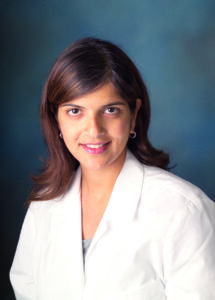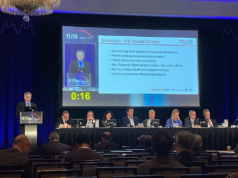
Addressing the audience at the 28th European Vascular Course (EVC 2025) in Maastricht, The Netherlands (March 9–11), Ulka Sachdev-Ost, MD, from the University of Pittsburgh Medical Center (UPMC) in Pittsburgh, Pennsylvania, set out a method to ensure limited funding is directed to the most pressing venous disease research needs.
“As everybody here in this room knows,” Sachdev-Ost began, “funding for research from a federal level—at least in the U.S. and I’m sure it’s similar in other countries—is actually pretty poor given the impact of venous disease for our patients and for the global population.”
Providing a more specific example, Sachdev-Ost homed in on chronic venous disease, which, the presenter shared, “affects quality of life for millions and millions of patients globally.” She also noted that the disease tends to be progressive and is associated with disability, depression, and immobility. “These are things that may not be life- or limb-threatening but certainly can affect how people are living their daily lives,” the presenter highlighted.
Sachdev-Ost also underlined a considerable financial burden associated with managing chronic venous disease, which is estimated to cost the US healthcare system $15 billion per year in some analyses.
Despite these considerable patient and monetary costs, Sachdev-Ost pointed out that there is very limited research focused on chronic venous disease. Citing a PubMed search, the presenter noted that the term ‘chronic venous disease’ yields around 24,000 hits compared to 211,000 for “coronary artery disease” and over three million for “cardiovascular disease.”
Against this backdrop, the presenter laid out her argument that venous specialists must “focus on identifying high-yield topics that would benefit from dedicated research dollars”. To do this, she proposed, venous research topics must be prioritized.
Sachdev-Ost highlighted the importance of multidisciplinary, multi-stakeholder projects to define research priorities, referring to the UK-based James Lind Alliance (JLA) as an example of such an initiative. “A big part of [the JLA] is to include patients,” she said. “You must include stakeholders if you’re going to come up with the appropriate research priorities.”
The presenter also detailed a recent multidisciplinary, research priority-setting effort she was involved in with the American Venous Forum (AVF).
Sachdev-Ost shared that she was chair of the AVF research committee in 2024–2025 and was tasked with materializing an idea from the former chair to come up with research priorities in the management of C2 disease, which she presented at the recent AVF annual meeting (Feb. 16–19) in Atlanta, Georgia.
The aim was to approach research priorities in a “transparent” way, Sachdev-Ost told the EVC audience. “We hypothesized that an open forum of brief presentations, open panel discussions and ranking surveys would identify scientific priorities in C2 disease and provide a foundation to design future research efforts,” she said.
The presenter explained that the forum comprised a 10-person multidisciplinary team from specialties including vascular surgery, interventional radiology, vascular medicine, and phlebology.
“We had a really, really good discussion,” Sachdev-Ost recalled, with topics—determined based on multiple discussions with the group—focusing on varicose vein management. “We ranked before and after the talk and found that really the etiology of varicose veins and equity were some of our big components.”
Concluding, Sachdev-Ost shared that the next step would be to include patients in the discussion to ensure that all stakeholders are involved in setting research priorities related to venous disease.
A question from Stephen Black, MD, from Guy’s and St Thomas’ NHS Foundation Trust and King’s College London in London, England, during discussion time highlighted further the importance of Sachdev-Ost’s point regarding patient involvement in setting research priorities.
“In the broader context of prioritizing venous disease against all the other disease states that we fight with,” Black began, “the challenge we face is that the impact of death and limb loss for aortic and arterial disease seems to always outweigh the significant quality-of-life destruction that venous patients have, and it becomes hard to challenge that. How do you go about doing that from a point of view of increasing the potential long-term impact of venous disease versus the other priorities?”
Sachdev-Ost responded: “I think that’s an area in which pulling in maybe more of the patient-centered perspective can be very helpful. For many years, peripheral arterial disease and the impact on the muscle was not really given a lot of attention but now a lot more interest I think is there in how much peripheral arterial disease can decrease mobility and create a whole other host of downstream problems that have enormous impacts on spending dollars etc. for the healthcare system. So, I think similar types of things can be done with venous disease and pulling in different stakeholders can really help define those metrics.”












